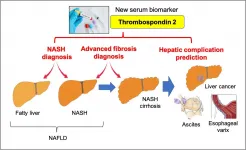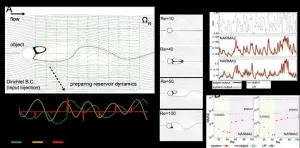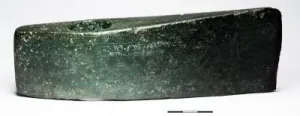A simple blood test to identify patients at risk of nonalcoholic fatty liver disease
Researchers at Osaka University identify a new noninvasive biomarker that can be used in the diagnosis of nonalcoholic fatty liver disease
2021-06-17
(Press-News.org) Osaka, Japan - Nonalcoholic fatty liver disease (NAFLD) is the most common liver disease worldwide and can progress to liver cirrhosis, liver failure or cancer. Currently, nonalcoholic steatohepatitis (NASH) diagnosis requires an invasive liver biopsy which can lead to procedural complications. Now, researchers at Osaka University working with international collaborators have identified a noninvasive biomarker that can identify patients at risk of NAFLD complications using a simple blood test.
Owing to the increasing prevalence of obesity worldwide, as many as one in four humans has NAFLD. Unrelated to alcohol intake by definition, the early stage - NAFL (nonalcoholic fatty liver) - is asymptomatic. Unfortunately, progression to NASH incurs inflammatory damage and eventually liver fibrosis occurs; this may further lead to adverse outcomes. Liver deterioration can be deferred by lifestyle modifications comprising diet and exercise; therefore, early diagnosis is key.
Diagnostic confirmation requires a needle biopsy; however, the disadvantages include expense and variability in sampling and interpretation. The research team investigated whether they could devise a diagnostic screen using transcriptomics, the emerging science of analyzing the 'transcriptome,' the entire array of an organism's messenger RNA molecules derived from expression of the genome.
"We obtained liver tissue from over 300 Japanese and European patients with biopsy-proven NAFLD and performed global RNA sequencing," co-first author Kazuhiro Kozumi explains. "Remarkably, from the protein patterns we could not only distinguish NASH from NAFL, but also determine the molecular hallmarks of NASH pathology. Specifically, we pinpointed that levels of thrombospondin-2 (TSP-2), a glycoprotein encoded by the THBS2 gene, were increased in both NASH and advanced fibrosis."
The researchers established that THBS2 expression in liver cells paralleled the clinical indicators conventionally used to categorize the pathological changes including serum enzyme levels, NAFLD Activity Score and NAFLD Fibrosis Score. "Serum levels of TSP-2 in NAFLD patients were significantly higher in NASH than in NAFL," co-first author Takahiro Kodama claims, "and, interestingly, the increase tallied with the degree of fibrosis."
Corresponding author Tetsuo Takehara explains the clinical relevance of their research findings. "Both hepatic THBS2 gene expression in the liver and serum protein levels of TSP-2 can diagnose cases of NASH and/or advanced fibrosis. A simple and convenient blood test can provide a clinically useful early warning system for complications of NAFLD and inform lifestyle modifications or other interventions that may alter the course of the disease and improve the prognosis."
INFORMATION:
The article, "Transcriptomics identify thrombospondin-2 as a biomarker for nonalcoholic steatohepatitis and advanced liver fibrosis" was published in Hepatology at DOI: https://doi.org/10.1002/hep.31995
About Osaka University
Osaka University was founded in 1931 as one of the seven imperial universities of Japan and is now one of Japan's leading comprehensive universities with a broad disciplinary spectrum. This strength is coupled with a singular drive for innovation that extends throughout the scientific process, from fundamental research to the creation of applied technology with positive economic impacts. Its commitment to innovation has been recognized in Japan and around the world, being named Japan's most innovative university in 2015 (Reuters 2015 Top 100) and one of the most innovative institutions in the world in 2017 (Innovative Universities and the Nature Index Innovation 2017). Now, Osaka University is leveraging its role as a Designated National University Corporation selected by the Ministry of Education, Culture, Sports, Science and Technology to contribute to innovation for human welfare, sustainable development of society, and social transformation.
Website: https://resou.osaka-u.ac.jp/en
[Attachments] See images for this press release:

ELSE PRESS RELEASES FROM THIS DATE:
2021-06-17
The electroreduction of carbon dioxide (CO2) to produce value-added multicarbon compounds is an effective way to cut down CO2 emission. However, the low solubility of CO2 largely limits the application of related technology.
Although gas diffusion electrode (GDE) can accelerate the reaction rate, the instability of the catalysts caused by electrolyte flooding hinders further reaction.
Recently, inspired by setaria's hydrophobic leaves, Prof. GAO Minrui's team from University of Science and Technology of China developed Cu catalyst composed of sharp needles which possesses high level ...
2021-06-17
When animals are hot, they eat less. This potentially fatal phenomenon has been largely overlooked in wild animals, explain researchers from The Australian National University (ANU).
According to lead author Dr Kara Youngentob, it means climate change could be contributing to more deaths among Australia's iconic marsupials, like the greater glider, than previously thought.
"Hot weather puts all animals off their food. Humans can deal with it fairly well; we usually have plenty of fat reserves and lots of different ...
2021-06-17
A destructive pest beetle is edging closer to Australia as biological controls fail, destroying home gardens, plantations and biodiversity as they surge through nearby Pacific islands.
University of Queensland researcher Dr Kayvan Etebari has been studying how palm-loving coconut rhinoceros beetles have been accelerating their invasion.
"We thought we'd outsmarted them," Dr Etebari said.
"In the 1970s, scientists from Australia and elsewhere found that coconut rhinoceros beetles could be controlled with a beetle virus from Malaysia.
"This virus stopped the beetle in its tracks and, for the last 50 years or so, it more-or-less stayed put ...
2021-06-17
As demand for electricity rises and climate change brings more frequent and extreme storms, residents in rural and suburban communities must have access to the minimal electricity they need to survive a large, long-duration (LLD) power outage.
A new study in the journal Risk Analysis compared strategies for providing emergency power to residents in two hypothetical New England communities during such an event. The results suggest that cooperative strategies like sharing a higher capacity generator among multiple homes cost 10 to 40 times less than if each household used its own generator.
"Our findings provide impetus for utilities, regulators, ...
2021-06-17
Osaka, Japan - A team of scientists headed by SANKEN (The Institute of Scientific and Industrial Research) at Osaka University demonstrated that single virus particles passing through a nanopore could be accurately identified using machine learning. The test platform they created was so sensitive that the coronaviruses responsible for the common cold, SARS, MERS, and COVID could be distinguished from each other. This work may lead to rapid, portable, and accurate screening tests for COVID and other viral diseases.
The global coronavirus pandemic has revealed the ...
2021-06-17
[Background]
In recent years, physical reservoir computing*1), one of the new information processing technologies, has attracted much attention. This is a physical implementation version of reservoir computing, which is a learning method derived from recurrent neural network (RNN)*2) theory. It implements computation by regarding the physical system as a huge RNN, outsourcing the main operations to the dynamics of the physical system that forms the physical reservoir. It has the advantage of obtaining optimization instantaneously with limited computational resources by adjusting linear and static readout weightings between the output and a physical reservoir without requiring optimization of the weightings by back propagation. However, since the information processing capability depends ...
2021-06-17
SINGAPORE, 17 June 2021 - New details on the structure and function of a transport protein could help researchers develop drugs for neurological diseases that are better able to cross the blood-brain barrier. The findings were published in the journal Nature by researchers at Columbia University Vagelos College of Physicians and Surgeons, Duke-NUS Medical School, Weill Cornell Medicine and colleagues.
Omega-3 fatty acids, like docosahexaenoic acid (DHA), are important for brain and eye development. They are derived mainly from dietary sources and converted ...
2021-06-17
New research presents over 300 new analyses of bronze objects, raising the total number to 550 in 'the archaeological fingerprint project'. This is roughly two thirds of the entire metal inventory of the early Bronze Age in southern Scandinavia. For the first time, it was possible to map the trade networks for metals and to identify changes in the supply routes, coinciding with other socio-economic changes detectable in the rich metal-dependent societies of Bronze Age southern Scandinavia.
The magnificent Bronze Age in southern Scandinavia rose from copper traded from the British Isles and Slovakia 4000 years ago. 500 ...
2021-06-17
In a paper published in NANO, a team of researchers from Jiangnan University, China have prepared a convenient sensing platform which can detect microRNA-205 (MiR-205) with high sensitivity and excellent selectivity using TpTta-COF nanosheet and fluorescent oligonucleotide probes.
Nasopharyngeal carcinoma (NPC) is a kind of malignant cancer derived from the epithelial cells, which shows an apparent regional aggregation with a high prevalence in Southern China and Southeast Asia. With the ongoing improvement of radiotherapy technology, the therapeutic effect of NPC patients has been increased significantly. However, the easy recurrence and metastasis still cause the poor prognosis of NPC patients. Many researches indicated that ...
2021-06-17
RUDN University mathematicians built a model of COVID-19 spreading based on two regression models. The mathematicians divided the countries into three groups, depending on the spreading rate and on the climatic conditions, and found a suitable mathematical approximation for each of them. Based on the model, the mathematicians predicted the subsequent waves. The forecast was accurate in countries where mass vaccination was not introduced. The results are published in Mathematics.
The epidemy spreading rate within the country depends, among other things, on the climatic ...
LAST 30 PRESS RELEASES:
[Press-News.org] A simple blood test to identify patients at risk of nonalcoholic fatty liver disease
Researchers at Osaka University identify a new noninvasive biomarker that can be used in the diagnosis of nonalcoholic fatty liver disease






